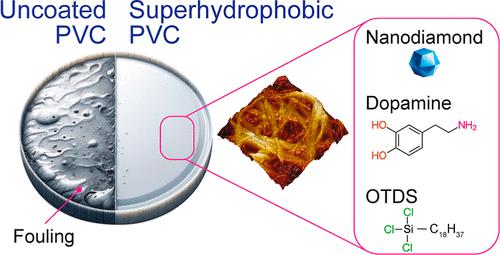当前位置:
X-MOL 学术
›
Ind. Eng. Chem. Res.
›
论文详情
Our official English website, www.x-mol.net, welcomes your feedback! (Note: you will need to create a separate account there.)
Bioinspired Superhydrophobic Nanocoating Based on Polydopamine and Nanodiamonds to Mitigate Bacterial Attachment to Polyvinyl Chloride Surfaces in Food Industry Environments
Industrial & Engineering Chemistry Research ( IF 4.2 ) Pub Date : 2024-03-27 , DOI: 10.1021/acs.iecr.3c04230 William DeFlorio 1 , Abdulla Zaza 2 , Yashwanth Arcot 1 , Younjin Min 3 , Alejandro Castillo 4 , Matthew Taylor 5 , Luis Cisneros-Zevallos 6 , Mustafa E. S. Akbulut 1
Industrial & Engineering Chemistry Research ( IF 4.2 ) Pub Date : 2024-03-27 , DOI: 10.1021/acs.iecr.3c04230 William DeFlorio 1 , Abdulla Zaza 2 , Yashwanth Arcot 1 , Younjin Min 3 , Alejandro Castillo 4 , Matthew Taylor 5 , Luis Cisneros-Zevallos 6 , Mustafa E. S. Akbulut 1
Affiliation

|
Polyvinyl chloride (PVC) is commonly utilized as a food-contact surface by the food industry for processing and storage purposes due to its durability, ease of fabrication, and cost-effectiveness. Herein, we report a composite coating for the superhydrophobization of PVC without the use of polyfluoroalkyl chemistry. This coating rendered the PVC superhydrophobic, exhibiting a static water contact angle of 151.9 ± 0.7° and a contact angle hysteresis of only 3.1 ± 1.0°. The structure of this composite coating, consisting of polydopamine, nanodiamonds, and an alkyl silane, was investigated by utilizing both scanning electron microscopy and atomic force microscopy. Surface chemistry was probed using attenuated total reflectance-Fourier transform infrared, and the surface wetting behavior was thoroughly characterized using both static and dynamic water contact angle measurements. It was demonstrated that the superhydrophobic PVC was cleanable using a food-grade surfactant, becoming wet in contact with high concentration surfactant solutions, but regaining its nonwetting property upon rinsing with water. It was demonstrated that the coating produced a 2.1 ± 0.1 log10 reduction (99.2%) in the number of Escherichia coli O157:H7 cells and a 2.2 ± 0.1 log10 reduction (99.3%) in the number of Salmonella enterica Typhimurium cells that were able to adsorb onto PVC surfaces over a 24 h period. The use of this fluorine-free superhydrophobic coating on PVC equipment, such as conveyor belts within food production facilities, may help to mitigate bacterial cross-contamination and curb the spread of foodborne illnesses.
中文翻译:

基于聚多巴胺和纳米金刚石的仿生超疏水纳米涂层可减轻食品工业环境中聚氯乙烯表面的细菌附着
由于其耐用性、易于制造和成本效益,聚氯乙烯 (PVC) 通常被食品工业用作食品接触表面,用于加工和储存目的。在此,我们报告了一种不使用多氟烷基化学物质的 PVC 超疏水化复合涂层。该涂层使 PVC 具有超疏水性,其静态水接触角为 151.9 ± 0.7°,接触角滞后仅为 3.1 ± 1.0°。利用扫描电子显微镜和原子力显微镜研究了这种由聚多巴胺、纳米金刚石和烷基硅烷组成的复合涂层的结构。使用衰减全反射傅里叶变换红外来探测表面化学,并使用静态和动态水接触角测量来彻底表征表面润湿行为。结果表明,超疏水性 PVC 可使用食品级表面活性剂进行清洁,与高浓度表面活性剂溶液接触时会变湿,但用水冲洗后会恢复其不润湿特性。结果表明,该涂层使大肠杆菌O157:H7 细胞数量减少了2.1 ± 0.1 log 10 (99.2%),而鼠伤寒沙门氏菌细胞数量则减少了2.2 ± 0.1 log 10 (99.3%)。能够在 24 小时内吸附到 PVC 表面。在 PVC 设备(例如食品生产设施内的传送带)上使用这种无氟超疏水涂层可能有助于减轻细菌交叉污染并遏制食源性疾病的传播。
更新日期:2024-03-27
中文翻译:

基于聚多巴胺和纳米金刚石的仿生超疏水纳米涂层可减轻食品工业环境中聚氯乙烯表面的细菌附着
由于其耐用性、易于制造和成本效益,聚氯乙烯 (PVC) 通常被食品工业用作食品接触表面,用于加工和储存目的。在此,我们报告了一种不使用多氟烷基化学物质的 PVC 超疏水化复合涂层。该涂层使 PVC 具有超疏水性,其静态水接触角为 151.9 ± 0.7°,接触角滞后仅为 3.1 ± 1.0°。利用扫描电子显微镜和原子力显微镜研究了这种由聚多巴胺、纳米金刚石和烷基硅烷组成的复合涂层的结构。使用衰减全反射傅里叶变换红外来探测表面化学,并使用静态和动态水接触角测量来彻底表征表面润湿行为。结果表明,超疏水性 PVC 可使用食品级表面活性剂进行清洁,与高浓度表面活性剂溶液接触时会变湿,但用水冲洗后会恢复其不润湿特性。结果表明,该涂层使大肠杆菌O157:H7 细胞数量减少了2.1 ± 0.1 log 10 (99.2%),而鼠伤寒沙门氏菌细胞数量则减少了2.2 ± 0.1 log 10 (99.3%)。能够在 24 小时内吸附到 PVC 表面。在 PVC 设备(例如食品生产设施内的传送带)上使用这种无氟超疏水涂层可能有助于减轻细菌交叉污染并遏制食源性疾病的传播。



























 京公网安备 11010802027423号
京公网安备 11010802027423号